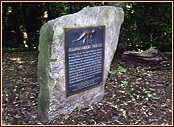

|

...
Re-establishing the "Lost"
Hadrosaurus Site, 1984
 
|
|
The location of the Haddonfield Hadrosaurus site was lost until 1984 when boy scout Christopher Brees organized a project to find and mark it.
The Hadrosaurus foulkii skeleton first erected in 1868 remained the premiere display at the Academy of Natural Sciences and other institutions until the turn of the century. Then, supplanted by discoveries and displays of much larger, fiercer dinosaur fossils -- such as Tyrannosaurus Rex -- the Hadrosaurus skeleton as well as the Haddonfield, N.J. site where it was found began receding from the public's interest and memory.
In Haddonfield, part of the ravine where the fossil had been found was used for many years as an unofficial dumping ground for household wastes. Two sewerage processing plants were built nearby and later demolished. Wild growth enveloped the area.
Local Boy Scout Resurrects Lost Site
Then, in 1984, a local Boy Scout -- 13-year-old Christopher Brees -- was casting about for a community service project to perform as part of his Eagle Scout qualification program. After reading a brief mention of Haddonfield's historic dinosaur discovery in a National Geographic publication, Brees couldn't find anyone in his neighborhood who actually knew where the site was. As a community service project he set out to find it.
After locating the site and appearing before the Haddonfield borough council to obtain permission to clean and mark it, Brees received small grants from the Philadelphia Academy of Natural Sciences and the Junior Women's Club of Haddonfield to fund various aspects of the project. More importantly, his actions generated newspaper publicity that rekindled local interest in the history of Haddonfield's nearly forgotten dinosaur.
Marker Stone Erected
Near the site, Brees found a 700-pound light brown stone that was put in place as a site marker. To finish it, he sculpted a plaque of clay that was cast in bronze and mounted on the stone. The plaque features a side view of Hadrosaurus foulkii and a site explanation written by Brees which reads:
"Hadrosaurus foulkii"
"In a marl pit on the John E. Hopkins farm in October, 1858 the world's first nearly-complete dinosaur skeleton was unearthed by William Parker Foulke. The find was adjacent to this point. This was also the first dinosaur skeleton to ever be mounted. The bones represented a 25 foot, seven to eight ton herbivorous hadrosaurus (reptile). Its height probably ranged from six to ten feet at the hip. Some 55 of an estimated 80 bones were discovered. This creature lived 70 to 80 million years ago during the Cretaceous period at the end of the dinosaur age."
"This site was developed in 1984 as an Eagle Scout project by Christopher Brees, Troop 65. Major project funding by the Academy of Natural Sciences, Philadelphia, Pennsylvania."
|
|
|
|
All Rights Reserved © 1995 - 2008, Hoag Levins
HoagL@earthlink.net
.
|


|









